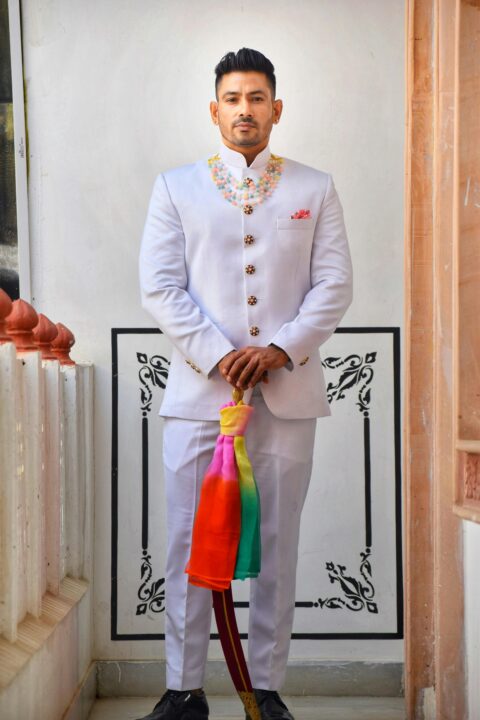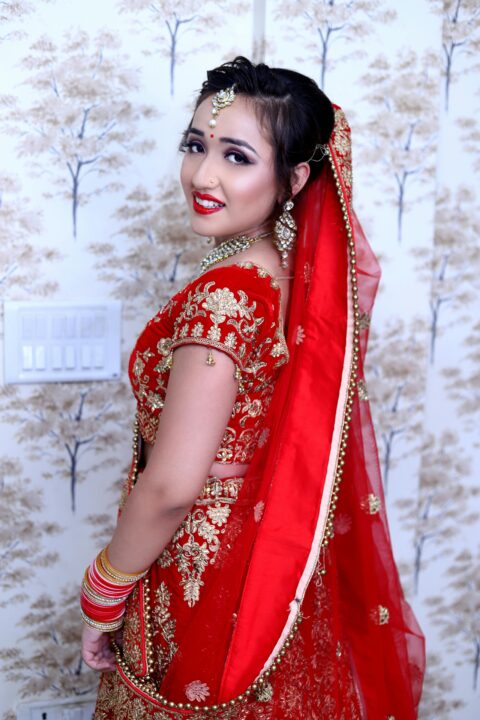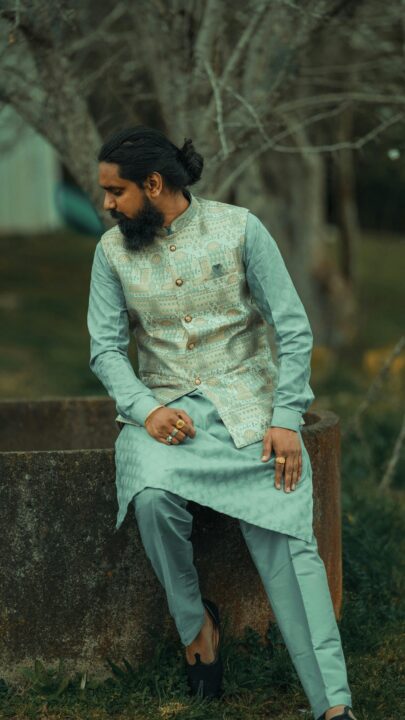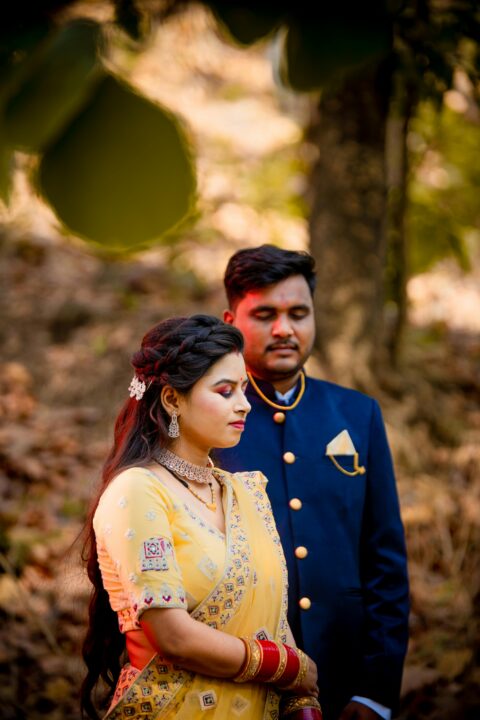Every tribe and nation has its own method of expressing its culture via clothing. Each style is unique, gorgeous, and well-represented.
However, every culture and tribe has both modern and traditional attire. This post will look at traditional Indian clothing names that you should be familiar with. In India, clothing is chosen or determined according to race, geography and cultural customs.
However, male and female attire have progressed beyond simple body-covering garments. These Indian garments include the kaupina, langota, achkan, lungi, Sari, gamcha, loincloths, and elaborate costumes used on special occasions and during dance performances.
Western clothing is commonly worn by people of all social classes in urban areas.
Continue reading to learn about traditional Indian clothing names
Indian Clothing Names: 11 Types of Indian Wear with Traditional and Modern Styles
1. Bandhgala

An Indian Jodhpuri or Bandhgala is elegant evening attire. It originated in Jodhpur and rose to prominence during the British Raj.
People also refer to it as a Jodhpuri suit. Along with the waistcoat, it combines a Western cut with Indian hand embroidery.
It is also ideal for formal occasions, such as weddings. You can make this cloth from silk or any other appropriate material. Typically, the collar and buttons have several embodiments.
Plain, jacquard, and jamewari are among the available materials. Even the coat and trousers are equally matched.
2. Lancha
Lancha is another type of lehenga choli. The distinction is in the choli style and skirts. In a lancha ensemble, the choli is typically longer than waist length and falls over the lehenga’s waistline.
Lancha is more modest apparel since it does not show the waist. Lanchas were traditionally worn by Mughal royalty and they are still popular in wedding, bridal and festive dress today.
3. Saree

Have you ever tried wrapping your mother’s dupatta like a saree? Even I did. The Saree is a classic Indian wrap and circle clothing that dates back to the Indus Valley civilization.
It is one of the most well-known styles of Indian attire. Rather than a single form of classical draperies saree, there are 80 varieties across the subcontinent. Examples include pleatless Bengali, Odi styles, Kodagu styles, and Malayali styles.
A saree comprises a blouse and an underskirt, over which material is wrapped in the desired style.
Traditionally, sarees were draperies garments. But now there is a substitute for that: stitched and pre-stitched sarees, which may be worn like gowns and do not require draping.
Not only have draping patterns altered dramatically in recent decades, but so have blouse designs. New versions feature a lot of Western inspiration, such as one-shoulder, off-the-shoulder, feathers, ruffles, capes and more.
Nevertheless, the notion of saree remains unchanged, and it is still prevalent in top fashion shows and Indian fashion collections ranging from luxury to budget.
4. Dhoti kurta
Men in India wear dhotis, which are among the most common styles of male traditional Indian apparel.
A dhoti is a white or colored cotton strip that is four to six feet long. Rural males are the major wearers of this traditional outfit.
To keep it in place, they wrap a fancy or flat, basic belt around their waist. However, due to its popularity throughout India, Dhotis are known by different names in many languages.It is referred to as dhotar in Marathi. A chadra is the Punjabi term for it.
Furthermore, they refer to it as “Dhotiyu” in Gujarati and “Pancha” in Telugu; it is a sort of plant. It is also known as Veshti in Tamil and Panche/Lungi in Kannada.
5. Anarkali suit
Anarkali consists of a long frock-style flared kurta and tightly fitted churidar pants. An anarkali dress is fitted until just above the waist, then flares to the knees.
Anarkali is a style of Indian clothing that has recently made a reappearance after decades. The current designs are floor-length and gown-like. It usually looks royal, sophisticated, and comfortable. Modern Anarkali suit styles include jacket, cape, tiered, floor-length, and gown.
6. Kurta & Churidar

Churidar can be worn with both frock-style and other kurtis, such as A-line, front-cut, short, and long-length kurtis.
Churidar trousers are longer than the length of the legs, and the excess length folds at the ankles to form bangles (churi), hence the name churidar.
This is another outfit from the Mughal era that was popular among Pakistani Punjabi women before to division. It is now widely worn in India and Pakistan.
7. Salwar Suit
The salwar kameez is the most comfortable style of Indian apparel. It combines salwar, kameez, and dupatta.
A salwar is a loose, pleated pajama that fits securely about the waist and tapers at the ankles. A kameez, on the other hand, is the upper part of the clothing that we wear over the salwar and is knee-length or longer these days.
Trends evolve, such as the style of kurtis and dupattas, but the substance remains constant. In recent years, we’ve seen both very short kurtis and ankle-length kurtas worn with various styles of salwars, such as trouser-style, asymmetric, or Patiala.
The dupatta has also taken on Indo-western characteristics like ruffles, lace, and feathers, which have occasionally disappeared entirely. It is a formal Indian dress that is more comfortable and elegant than a saree or lehenga.
8. Women’s Sherwani
Sherwani first appeared in the Mughal era as men’s clothing, worn by royalty and noblemen. However, in recent years, sherwani has evolved into women’s attire.
Sherwani outfits are available in a variety of fabrics, including silk, cotton, chanderi, net, chiffon, georgette, tussar, velvet, and others.
If you want to wear something other than a suit or a saree, this is the costume for you. This is a very new form of Indian clothing.
Unlike kurtas, which are worn over the head, sherwanis often have front closures and mandarin collars. Sherwanis, which are typically elaborately embroidered throughout, are ideal for weddings, festival festivities, and graduation ceremonies.
9. Indo-Western Suits
Nowadays, we find a variety of Indian wear styles, such as palazzos and pantsuits, which are a mix of Indian and Western styles that are quite popular.
Palazzo suits are kurtis coupled with pleated, loose trousers known as palazzos. Kurtis now comes in a variety of styles, including A-line, long, short, off-the-shoulder, and more.
Pantsuits are fitted pants or trousers coupled with various sorts of kurtis. Aside from these, we’re seeing cropped, boot-cut, and cigarette pants. Indo-western outfits are typically worn sans a dupatta.
10. Indian Gowns
Another Western-inspired garment, the Indian gown, is typically worn with a dupatta and decorated with Indian surface work.
Gowns are available in a variety of forms nowadays, and they have become one of the most popular types of Indian wear during the last decade.
For example, off-shoulder, one-shoulder, bell-sleeved, saree-style gowns, and many more. They are also coupled with shrugs, capes, and jackets, providing a new twist to the gown concept.
Over the previous few years, we’ve seen feathers, bows, fringes, and other Western-inspired decorations on runways.
11. Sharara and Gharara Suits
We all frequently confuse shararas and ghararas since they seem so similar. Both began during the Mughal era.
They are traditionally from Lucknow, where most Muslim ladies wore them. Pakistani brides traditionally wear these dresses at their weddings.
The gharara and sharara suit comprises long, mid, or short kurtis paired with flared trousers known as gharara or sharara and dupatta.
Ghararas are well-structured, pleated pants. They are fitted close to the body till the knee, then flare out at or slightly above the knee. The seam is frequently embellished with piping or golden zari lace.



